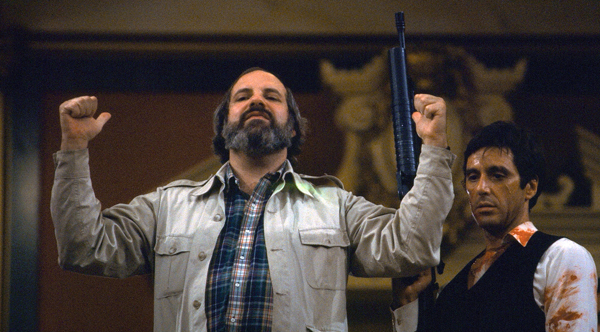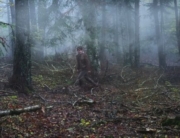With a body of work that includes the film version of Stephen King’s first novel, erotically tinged takes on Alfred Hitchcock, Bruce Springsteen’s “Dancing in the Dark” music video, the gangster flick that’s inspired a generation of hip-hop artists, and the first of the “Mission Impossible” franchise, Brian De Palma’s career is a testament to his own words: “People don’t understand that directors don’t plan their careers. We do the thing we can do at the time and start from scratch many times over.”
Here, the acclaimed—and often maligned—director of Carrie, Dressed to Kill, and Scarface takes an honest, insightful, and often funny look at his path, a career that’s resulted in plenty of box office hits—but more than a few clunkers. The film follows a fairly typical trajectory, with De Palma chronicling his life, describing a fairly idyllic childhood, his undergraduate experience at Columbia University, and his graduate work at Sarah Lawrence College. From there, he goes film by film, sharing his musings on his work, the response from critics, and a plethora of cocktail party–worthy anecdotes.
This is a stripped down, no-frills work. Directors Noah Baumbach (The Squid and the Whale, Frances Ha) and Jake Paltrow (The Young Ones) wisely remain behind the camera, letting De Palma take center stage. While the documentary includes plenty of scenes from De Palma’s films as well as those that influenced him, the interviewers never include themselves on camera, and there are no fawning testimonials from peers or fellow filmmakers. But De Palma has more than enough personality to keep the film from lagging, holding court on both his lesser-known works and his huge successes.
Viewers will come away with a good mix of information. There are plenty of festively gossipy anecdotes that will be familiar to anyone who’s spent a decent amount of time on IMDb (Orson Welles being unable to remember his lines on the set of Get to Know Your Rabbit, and Sean Connery objecting to the large number of squibs placed onto him for his death scene in The Untouchables—with De Palma expressing disbelief that James Bond of all people had so little experience with being shot).
However, De Palma also provides perspective into his cinematic process, offering an account of how obtaining an elaborate shot for the blood-soaked Carrie took a full day of shooting; discussing when one of his trademark techniques, the split screen, works and when it doesn’t; and offering parallels between the shower scene in Hitchcock’s Psycho and the moment in Dressed to Kill in which Angie Dickinson’s character is killed in an elevator.
And De Palma doesn’t shy away from his other, less cerebral side. He holds forth on the sleazy, blood-and-guts factor with gusto, cementing his reputation as the thinking man’s B movie director. While he expounds on his use of the tracking shot in Body Double, as well as the film’s similarities to Vertigo, he also mentions, with glee, how he considered casting a porn star in the role that went to Melanie Griffith (much to the horror of studio) and how he came under fire for the use of an almost cartoonishly long drill in the infamous murder scene; he explains, matter-of-factly, how his choice was necessary—it needed to be that long to impale the victim and go through the floor for the witness on the floor below to realize what was going on.
The filmmaker comes across as charismatic, likable even when his ego is on display. Though he’s often a bit dismissive of other films (his favorite part of watching remakes of Carrie is seeing other people make the errors he was able to avoid, and he calls himself the only director who has attempted to emulate Hitchcock), he’s somehow still endearing—and witty (for a straightforward documentary, there are more than a few chuckle-worthy moments)—and he’s quick to point out his own mistakes. He discusses how he should have swapped the A and B plots in Raising Cain and how The Bonfire of the Vanities wasn’t dark or cynical enough, considering Tom Wolfe’s source material.
By contrast, relatively little on the director’s personal life comes through, and when it does, it’s only when relevant to his films: De Palma alludes to a relationship with a married woman that inspired a plot point in Raising Cain, and he describes how he saw himself in Dressed to Kill’s Peter Miller, a nerdy, science-loving teen who tracks down his mother’s murderer, just as De Palma spied on his father to confirm that he was having an affair. And while the filmmaker discusses casting Nancy Allen in many of his movies—and even briefly mentions his marriage to her not working out—there’s relatively little emotion on display. Friendships with directors such as Steven Spielberg, George Lucas, and Martin Scorsese (“Marty”) are brought up, as is De Palma’s work with Robert De Niro (“Bobby”), who starred in early, more experimental works, such as Greetings and Hi, Mom!, as well as the grand, operatic The Untouchables, but again, the focus is on the work.
Those new to De Palma’s work should be forewarned of spoilers. Climactic scenes are given away left and right, making this documentary more appropriate to those with a basic grounding in the man’s work. But those who may have dismissed De Palma because of what they see as the senseless violence or misogyny of his movies may come away with a greater appreciation of the director, while longtime fans will enjoy the opportunity to spend time in the company of a filmmaker whose tastes for sex and gore belie a genuine artistic sensibility.

















Leave A Comment